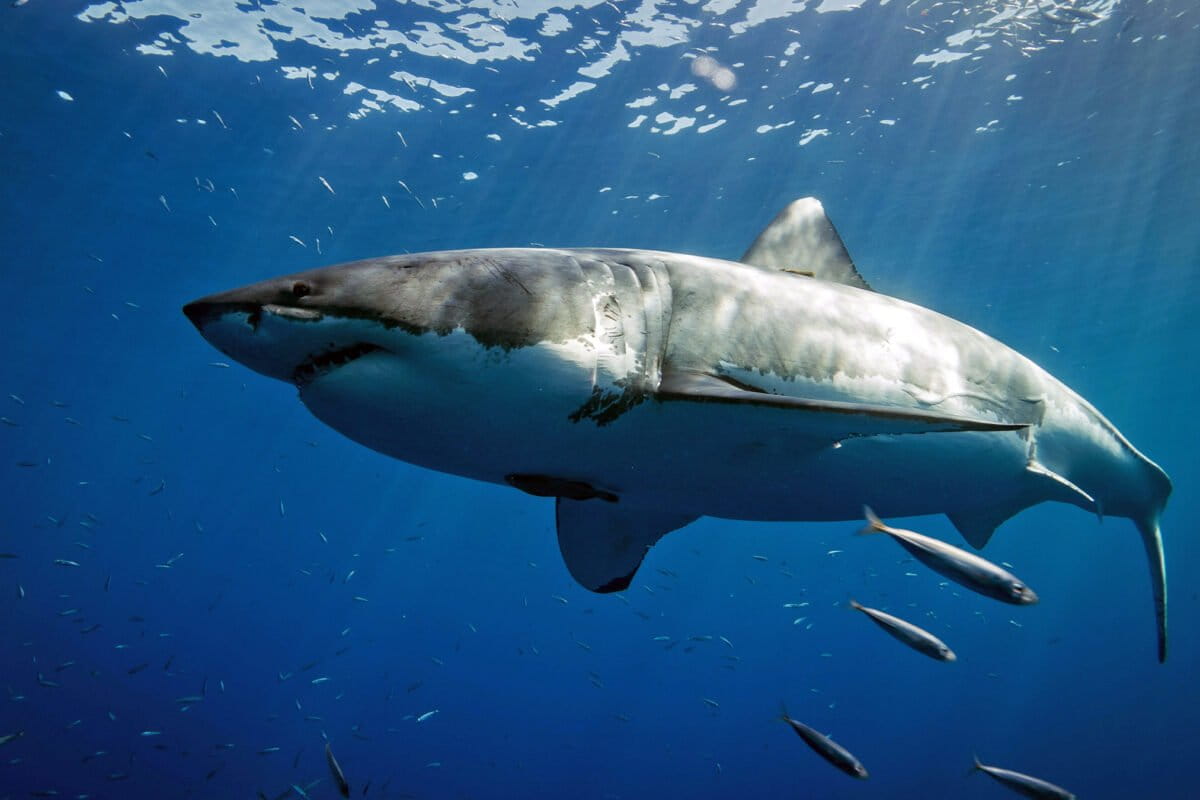The discovery of a satellite tag from a subadult female white shark in Indonesia marks the first recorded connectivity of white shark movement between South Africa and Southeast Asia.The white sharks found in South Africa and Australia belong to different genetic pools, which makes the two populations distinct from one another, even though they share the same migratory route.The biggest threats facing white sharks in South Africa and Indonesia are unsustainable fishing, where the sharks become both the bycatch and main catch.While there are attempts to support local fishers to pioneer shark conservation instead of hunting them, such efforts are thwarted by lack of funding.
See All Key Ideas
In May 2012, a satellite transmitter was attached to a subadult female white shark (Carcharodon carcharias) by OCEARCH as part of its shark expeditions in Gansbaai, a fishing town in Western Cape, South Africa.
Twelve years and 37,178 kilometers (23,101 miles) later, a fisherman in Indonesia handed over the tag to Project Hiu, a local NGO.
The tag belonged to a shark named Alisha, whose long journey had ended in 2016 in the longline gear of the fisherman in East Lombok, where she was originally misidentified as a mako shark (Isurus paucus).
In 2024, when the fisher finally handed over the tag, it triggered an international effort to recover and identify the tag, providing new information for conservationists about the distance a shark can travel.
Alisha’s journey also became the first documented movement of a white shark between South Africa and Southeast Asia, which was recorded in this paper published in June.
“You’ve never really seen a shark displaced so far,” said Dylan Irion, the corresponding author of the paper and co-founder of Cape RADD, noting that Alisha traveled a lot farther than another female shark called P12 that made a similar journey from South Africa to Australia in 2004, completing a round-trip migration of more than 20,000 km (12,400 mi).
Irion told Mongabay that Alisha’s journey was remarkable not just for the distance she traveled, but also because she passed through different habitats, from the cold-temperate waters off South Africa to the warm tropical waters in Mozambique, Madagascar and eventually Indonesia.
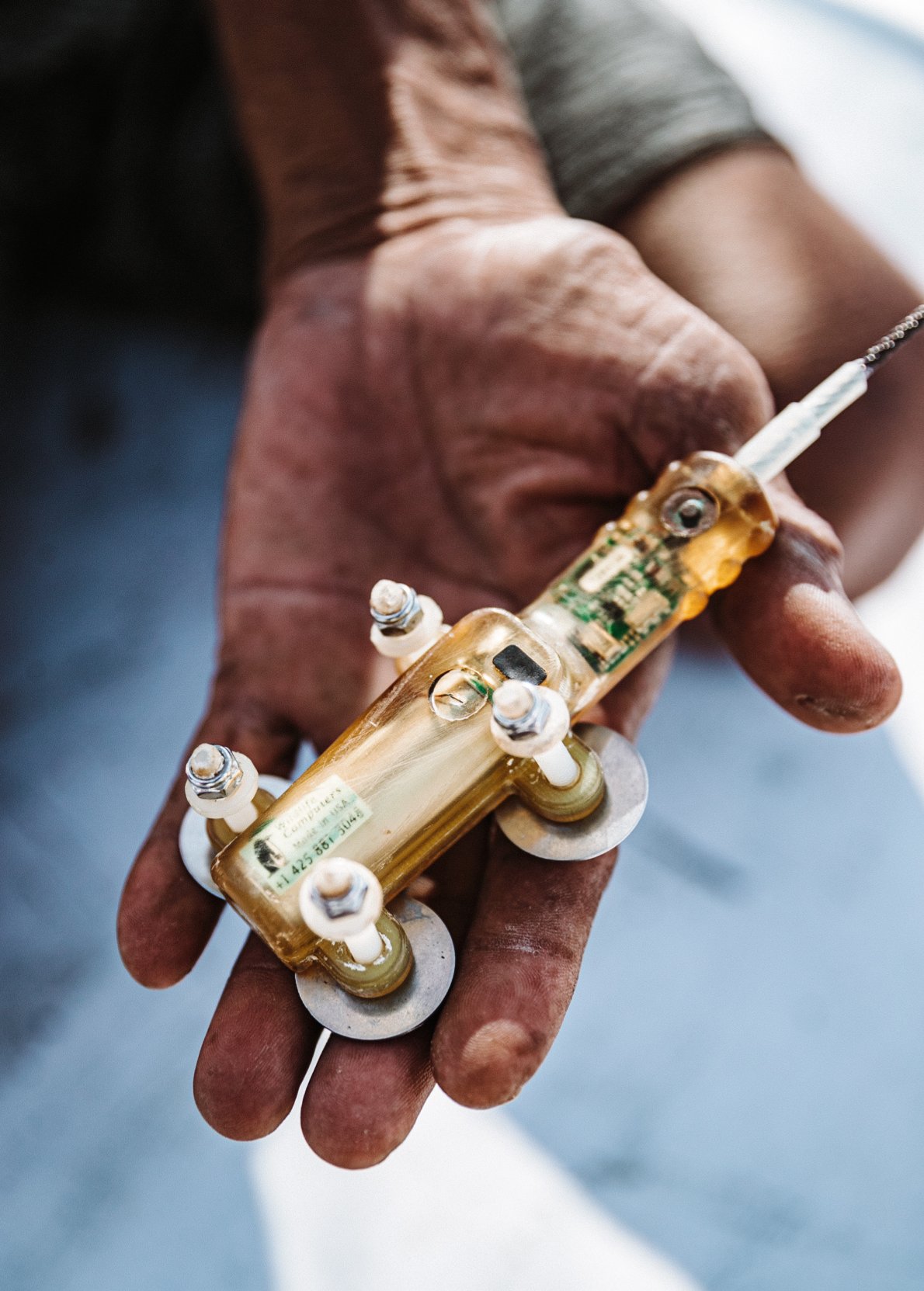 The fisher had kept the satellite tag of Alisha the great white shark for eight years, since 2016, out of fear of repercussions before giving it to Project Hiu in 2024. Image courtesy of Caragh Fraser.
The fisher had kept the satellite tag of Alisha the great white shark for eight years, since 2016, out of fear of repercussions before giving it to Project Hiu in 2024. Image courtesy of Caragh Fraser.
White shark populations and misidentifications
Globally, white sharks are divided into three groups: the Mediterranean and Indo-Pacific Oceans (Australia and California), the northwest Atlantic and Indian Ocean and a single divergent group restricted to South Africa.
“The fact that they traveled from South Africa to Southeast Asia and Australia tells us a great deal of their migratory route, but even that does not necessarily mean they travel there to breed,” said Sara Andreotti, a postdoctoral researcher in management and conservation of white sharks from Stellenbosch University, who is not directly involved in the study.
The paper also states that historically, there have been few documented sightings of white sharks in Southeast Asia, let alone in Indonesia. However, because the fisher had misidentified Alisha as a longfin mako shark, researchers started considering the possibilities of other instances of misidentifications and that perhaps there may be more occurrences of white sharks in Indonesian waters.
The misidentification, explained Fahmi Amhar, principal researcher at Indonesia’s Research Center for Oceanography, National Research and Innovation Agency known as BRIN, was due to the absence of information for identifying white sharks within the guidebook used in shark catch recording programs.
“Oftentimes, the people who are doing the identification are not well-trained. They are not knowledgeable enough to identify the sharks correctly, especially species not native to Indonesia, like the white sharks,” he told Mongabay.
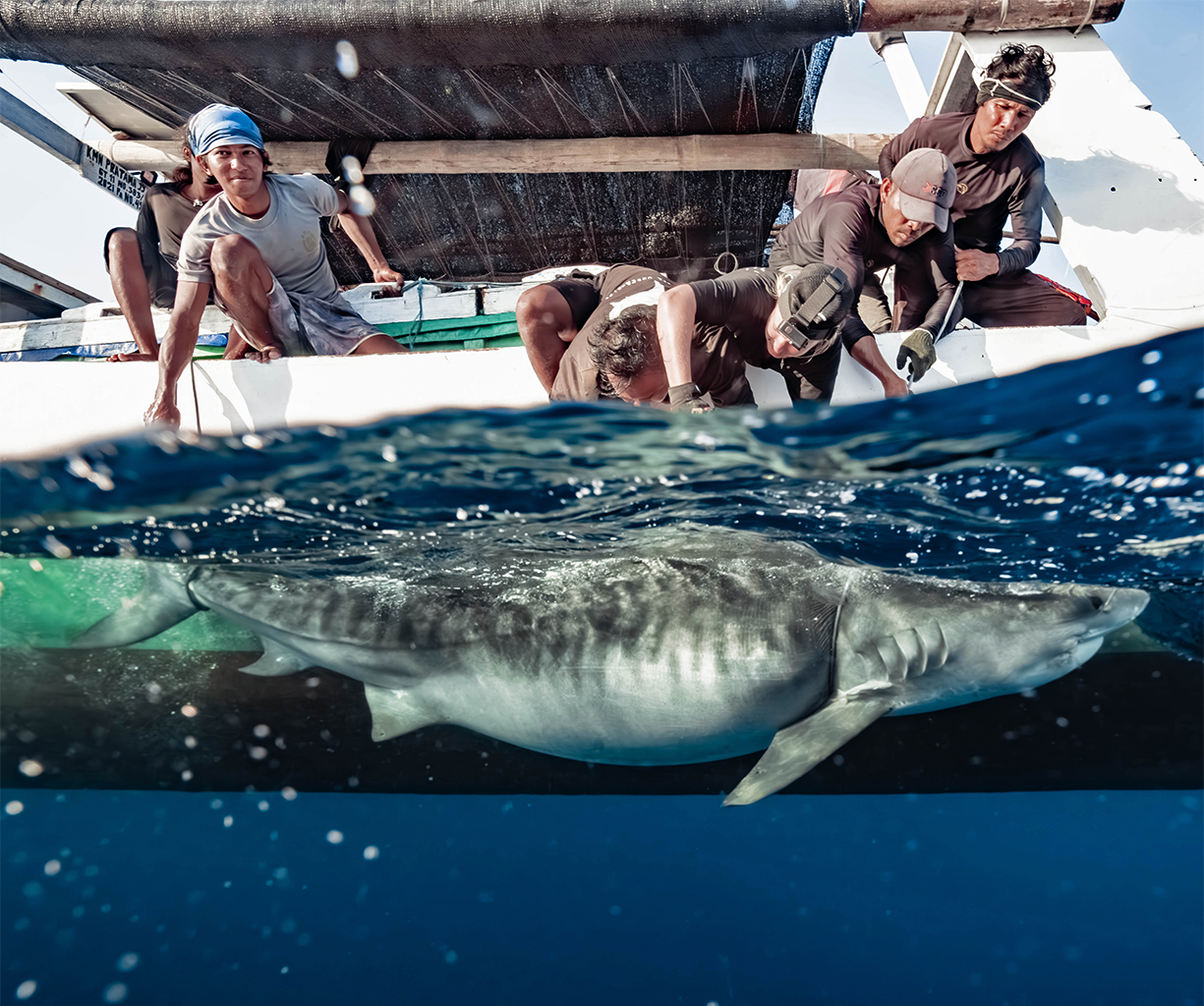 One of the tiger sharks that was being tagged and tracked by Project Hiu. Shark tagging can help provide real-time data regarding their movement and dispersal. This, in turn, can provide insights into certain aggregation sites and to better protect them, especially in Indonesian waters. Image courtesy of Caragh Fraser.
One of the tiger sharks that was being tagged and tracked by Project Hiu. Shark tagging can help provide real-time data regarding their movement and dispersal. This, in turn, can provide insights into certain aggregation sites and to better protect them, especially in Indonesian waters. Image courtesy of Caragh Fraser.
Threats in South Africa and Indonesia
In South Africa, the biggest threat that is depleting white shark populations is unsustainable shark fishing. A 2022 study led by Alison Kock revealed that an average of 28 white sharks were legally killed every year from 1978 to 2018 by shark nets and drumlines operated by the KwaZulu-Natal Sharks Board, a “shark control” program off the coast of KwaZulu-Natal Province, South Africa.
That number excludes the longline fisheries, which were thought to have killed an average of 40 white sharks annually from 2008-19 based on a rough estimate using numbers from South Africa’s Department of Forestry, Fisheries and the Environment.
When combined, these fisheries can decimate the white shark population, as a 2022 study co-authored by Irion estimated that even if only 10 white sharks are killed every year, it would have driven the overall population into decline.
“Sharks generally take a long time to reach maturity, so if females are not surviving, then their lifetime reproductive output is low. Couple that with a low population and it doesn’t take much to severely limit the potential for population growth,” Irion said.
Similarly in Indonesia, especially Lombok, shark fishing is still a big source of income for local fishers, and it’s not only for their fins, but the shark meat as a whole (there have been instances where shark meat is mislabeled, so consumers don’t even know they’re eating shark meat).
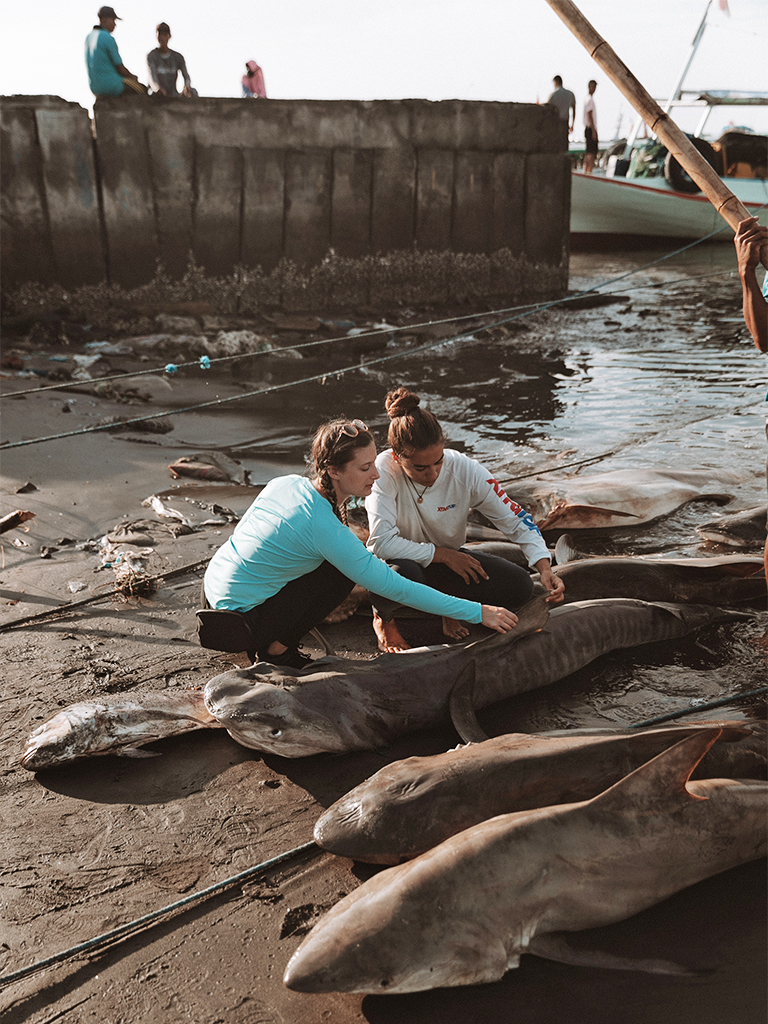 The fishery in Lombok that Project Hiu is working with to repurpose shark fishing boats in tourism. Image courtesy of Caragh Fraser.
The fishery in Lombok that Project Hiu is working with to repurpose shark fishing boats in tourism. Image courtesy of Caragh Fraser.
“The situation in Lombok is a bit different because sharks are the main catch, unlike in other places where they become bycatch. But to catch the sharks, the fishermen need to have permits from the Ministry of Maritime Affairs and Fisheries,” Fahmi explained.
“It’s complicated because first, it’s a tradition that’s been passed down from their ancestors, the Bajo people, and second, the demand is still there, which is why it persists. So, you can’t just tell them to stop hunting sharks and not provide an alternative because it’s their livelihood,” he further added.
Alisha’s tag was brought to the shark researchers’ attention because Project Hiu had offered monetary reward for the shark fishers in Lombok if they happened to see or recover any tags from their catch.
For several years now, Project Hiu has been working with local fishers to conserve sharks by deploying satellite tags. In 2023, more than 600 sharks were saved by repurposing shark fishing vessels, according to Project Hiu.
Their shark-tagging initiatives have also given hope for both the fishers and sharks to have better lives — as well as pioneered research into the behavior and dispersal of sharks in Indonesian waters with hopes of predicting their future movements to better protect them.
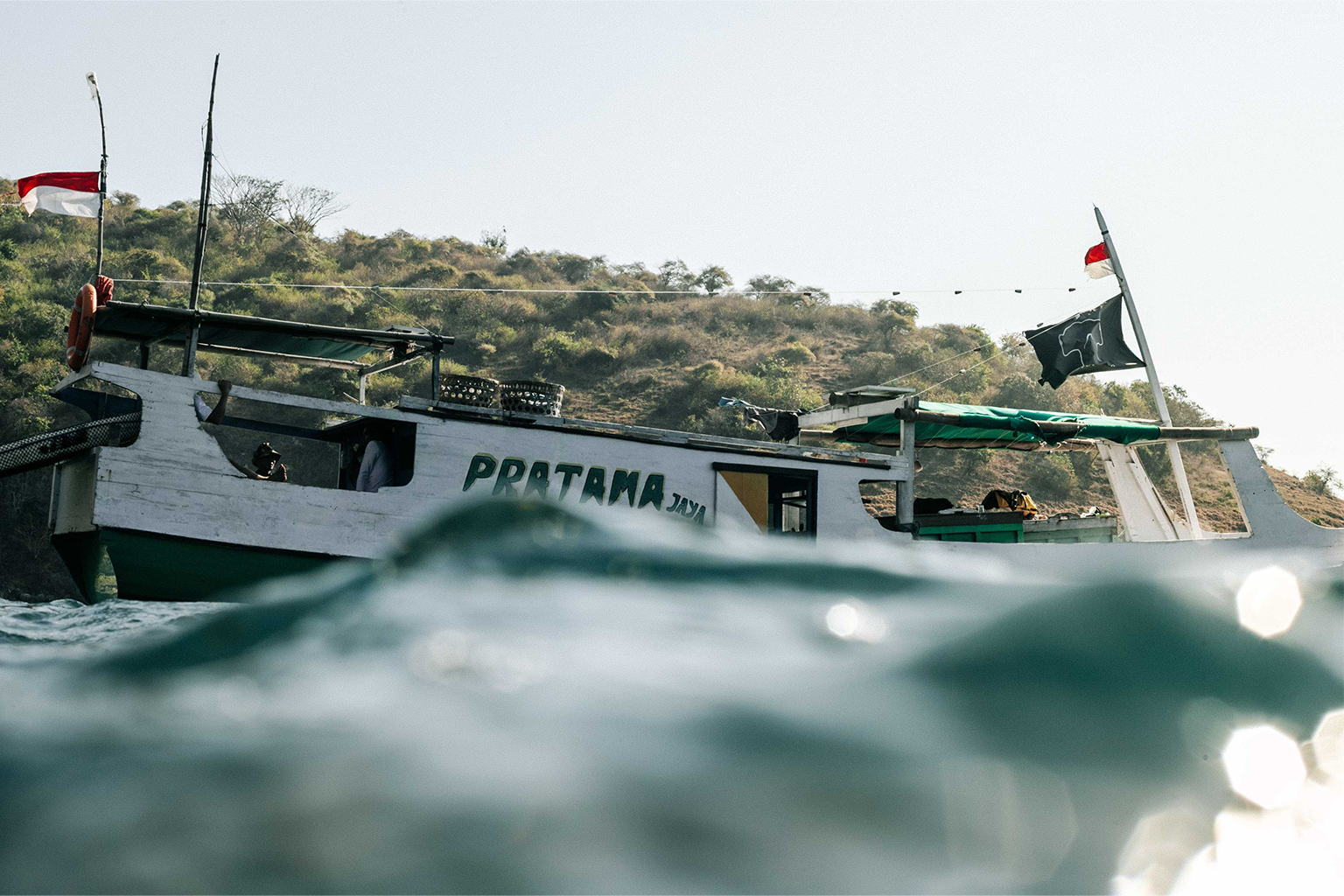 A shark fisher boat that was hired by Project Hiu to be repurposed for tourism and shark research. Image courtesy of Caragh Fraser.
A shark fisher boat that was hired by Project Hiu to be repurposed for tourism and shark research. Image courtesy of Caragh Fraser.
Challenges in shark conservation
In an email conversation, Project Hiu founder Madison Stewart said funding remains their biggest challenge in converting more shark fishing vessels in Lombok.
“We have no problem getting the fishermen to work in tourism instead of fishing sharks; it’s something they really want to do. However, we don’t have the funding to hire all the boats we want to,” Stewart wrote.
While she acknowledged weak law enforcement and huge gaps in conservation as the other big challenges, Stewart said she believes what is going to save sharks in Indonesia are “small grassroots projects that are working with locals and standing between them and the shark fin trade.”
“For me at least, the reason for publishing this is to show how important it is to work across borders and collaborate internationally, as well as to build relationships with the local communities — like what ProjectHiu is doing — to find new ways of coexisting,” Irion added.
Banner image: A photo of great white shark swimming in the open ocean courtesy of Gerald Schömbs via Unsplash.
Citations:
Irion, D. T., Jewell, O. J. D., Towner, A. V., Fahmi, Fischer G. C., Gennari, E., Stewart, M., Tyminski, J. P., & Kock, A. A. (2025) Transoceanic dispersal and connectivity of a white shark (Carcharodon carcharias) between southern Africa and Southeast Asia. Wildlife Research, 52, WR24145. doi: 10.1071/WR24145
Bonfil, R., Meÿer, M., Scholl, M. C., Johnson, R., O’Brien, S., Oosthuizen, H., … Paterson, M. (2005). Transoceanic migration, spatial dynamics, and population linkages of white sharks. Science, 310(5745), 100-103. doi:10.1126/science.1114898
Bowlby, H. D., Hammerschlag, N., Irion, D. T., & Gennari, E. (2022). How continuing mortality affects recovery potential for prohibited sharks: The case of white sharks in South Africa. Frontiers in Conservation Science, 3:988693. doi:10.3389/fcosc.2022.988693
Andreotti, S., Von der Heyden, S., Henriques, R., Rutzen, M., Meÿer, M., Oosthuizen, H., & Matthee, C. A. (2015). New insights into the evolutionary history of white sharks, Carcharodon carcharias. Journal of Biogeography, 43(2), 328-339. doi:10.1111/jbi.12641
Kock, A. A., Lombard, A. T., Daly, R., Goodall, V., Meÿer, M., Johnson, R., Fischer, C., Koen, P., Irion, D., Gennari, E., Towner, A., Jewell, O. J. D., da Silva, C., Dicken, M. L., Smale, M. J. & Photopoulou, T. (2022).Sex and Size Influence the Spatiotemporal Distribution of White Sharks, With Implications for Interactions With Fisheries and Spatial Management in the Southwest Indian Ocean. Frontiers in Conservation Science, 9:811985. doi:10.3389/fmars.2022.811985

